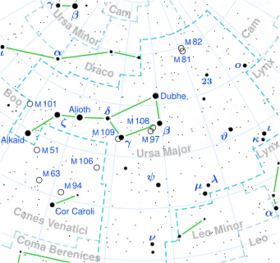Astronomy:15 Leonis Minoris
| Observation data Equinox J2000.0]] (ICRS) | |
|---|---|
| Constellation | Ursa Major[1] |
| Right ascension | 09h 48m 35.37130s[2] |
| Declination | +46° 01′ 15.6338″[2] |
| Apparent magnitude (V) | 5.08[3] |
| Characteristics | |
| Spectral type | G0 IV-V[4] |
| U−B color index | +0.175[5] |
| B−V color index | 0.619±0.007[3] |
| Astrometry | |
| Radial velocity (Rv) | 5.20±0.09[6] km/s |
| Proper motion (μ) | RA: 221.788[2] mas/yr Dec.: −92.816[2] mas/yr |
| Parallax (π) | 52.8994 ± 0.1260[2] mas |
| Distance | 61.7 ± 0.1 ly (18.90 ± 0.05 pc) |
| Absolute magnitude (MV) | 3.75[7] |
| Details | |
| Mass | 1.15[8] M☉ |
| Radius | 1.52[9] R☉ |
| Luminosity | 2.912±0.010[2] L☉ |
| Surface gravity (log g) | 4.04[4] cgs |
| Temperature | 5,859[4] K |
| Metallicity [Fe/H] | 0.01[4] dex |
| Rotational velocity (v sin i) | 3.97[10] km/s |
| Age | 9.3[11] Gyr |
| Other designations | |
| Database references | |
| SIMBAD | data |
15 Leonis Minoris is the Flamsteed designation for a single[13] star in the northern circumpolar constellation of Ursa Major. It has an apparent visual magnitude of 5.08,[3] making it a fifth magnitude star that is visible to the naked eye. Based on parallax measurements, it is located at a distance of 61.7 light years from the Sun. The star has been examined for an infrared excess, but none was detected.[14]
This star has a stellar classification of G0 IV-V[4] with an age of about 9.3 billion years,[11] which suggests that it is an older G-type main sequence star that may be evolving into a subgiant as the hydrogen at its core runs out. The estimated mass of the star is 15% greater than the Sun's mass,[8] and it is larger in girth than the Sun by +52%.[9] It is spinning with a projected rotational velocity of 4 km/s.[10] The star is radiating almost three[2] times the luminosity of the Sun from its photosphere at an effective temperature of 5,859 K,[4] giving it the yellow-hued glow of a G-type star.[15]
References
- ↑ Hoffleit, D. (1979), "Discordances in Star Designations", Bulletin d'Information du Centre de Données Stellaires 17: 38, Bibcode: 1979BICDS..17...38H.
- ↑ 2.0 2.1 2.2 2.3 2.4 2.5 2.6 Brown, A. G. A. (August 2018). "Gaia Data Release 2: Summary of the contents and survey properties". Astronomy & Astrophysics 616: A1. doi:10.1051/0004-6361/201833051. Bibcode: 2018A&A...616A...1G. Gaia DR2 record for this source at VizieR.
- ↑ 3.0 3.1 3.2 Anderson, E.; Francis, Ch. (2012), "XHIP: An extended hipparcos compilation", Astronomy Letters 38 (5): 331, doi:10.1134/S1063773712050015, Bibcode: 2012AstL...38..331A.
- ↑ 4.0 4.1 4.2 4.3 4.4 4.5 Gray, R. O. et al. (July 2006), "Contributions to the Nearby Stars (NStars) Project: spectroscopy of stars earlier than M0 within 40 pc-The Southern Sample", The Astronomical Journal 132 (1): 161–170, doi:10.1086/504637, Bibcode: 2006AJ....132..161G.
- ↑ Mermilliod, J.-C. (1986), "Compilation of Eggen's UBV data, transformed to UBV (unpublished)", SIMBAD Astronomical Database, Bibcode: 1986EgUBV........0M.
- ↑ Nidever, David L. et al. (August 2002), "Radial Velocities for 889 Late-Type Stars", The Astrophysical Journal Supplement Series 141 (2): 503–522, doi:10.1086/340570, Bibcode: 2002ApJS..141..503N.
- ↑ Luck, R. Earle; Heiter, Ulrike (2006), "Dwarfs in the Local Region", The Astronomical Journal 131 (6): 3069–3092, doi:10.1086/504080, Bibcode: 2006AJ....131.3069L.
- ↑ 8.0 8.1 Ramírez, I. et al. (September 2012), "Lithium Abundances in nearby FGK Dwarf and Subgiant Stars: Internal Destruction, Galactic Chemical Evolution, and Exoplanets", The Astrophysical Journal 756 (1): 46, doi:10.1088/0004-637X/756/1/46, Bibcode: 2012ApJ...756...46R.
- ↑ 9.0 9.1 Takeda, Genya; Ford, Eric B.; Sills, Alison; Rasio, Frederic A.; Fischer, Debra A.; Valenti, Jeff A. (2007), "Structure and Evolution of Nearby Stars with Planets. II. Physical Properties of ~1000 Cool Stars from the SPOCS Catalog", The Astrophysical Journal Supplement Series 168 (2): 297, doi:10.1086/509763, Bibcode: 2007ApJS..168..297T.
- ↑ 10.0 10.1 Martínez-Arnáiz, R. et al. (September 2010), "Chromospheric activity and rotation of FGK stars in the solar vicinity. An estimation of the radial velocity jitter", Astronomy and Astrophysics 520: A79, doi:10.1051/0004-6361/200913725, Bibcode: 2010A&A...520A..79M, http://eprints.ucm.es/37826/1/davidmontes17libre.pdf, retrieved 2018-11-04.
- ↑ 11.0 11.1 Ballering, Nicholas P. et al. (September 2013), "A Trend between Cold Debris Disk Temperature and Stellar Type: Implications for the Formation and Evolution of Wide-orbit Planets", The Astrophysical Journal 775 (1): 14, doi:10.1088/0004-637X/775/1/55, 55, Bibcode: 2013ApJ...775...55B.
- ↑ "* 15 LMi". SIMBAD. Centre de données astronomiques de Strasbourg. http://simbad.u-strasbg.fr/simbad/sim-basic?Ident=%2A+15+LMi.
- ↑ Eggleton, P. P.; Tokovinin, A. A. (September 2008), "A catalogue of multiplicity among bright stellar systems", Monthly Notices of the Royal Astronomical Society 389 (2): 869–879, doi:10.1111/j.1365-2966.2008.13596.x, Bibcode: 2008MNRAS.389..869E.
- ↑ Moro-Martín, A. et al. (March 2015), "Does the Presence of Planets Affect the Frequency and Properties of Extrasolar Kuiper Belts? Results from the Herschel Debris and Dunes Surveys", The Astrophysical Journal 801 (2): 28, doi:10.1088/0004-637X/801/2/143, 143, Bibcode: 2015ApJ...801..143M.
- ↑ "The Colour of Stars", Australia Telescope, Outreach and Education (Commonwealth Scientific and Industrial Research Organisation), December 21, 2004, archived from the original on March 18, 2012, https://web.archive.org/web/20120318151427/http://outreach.atnf.csiro.au/education/senior/astrophysics/photometry_colour.html, retrieved 2016-07-25.
 |


